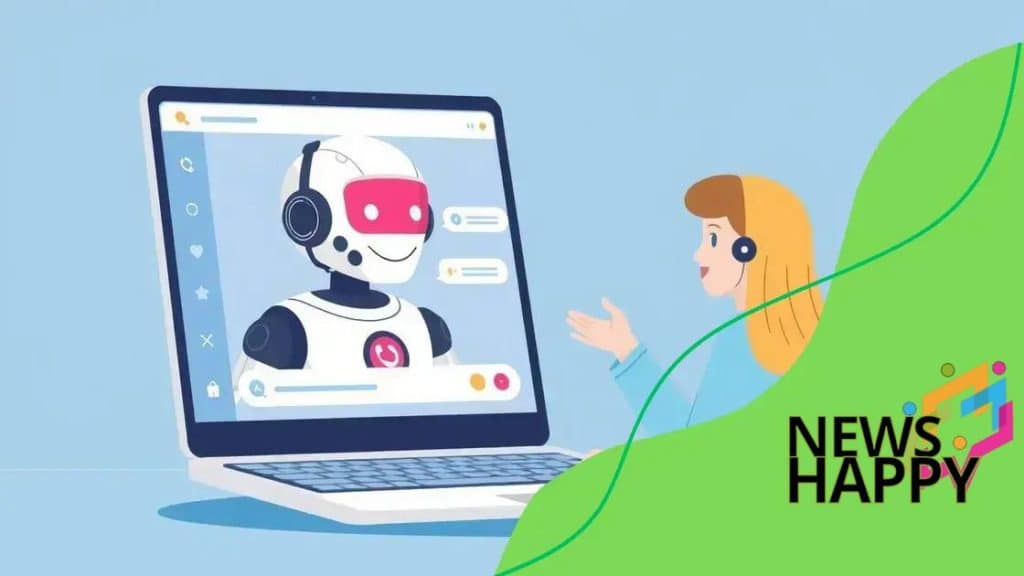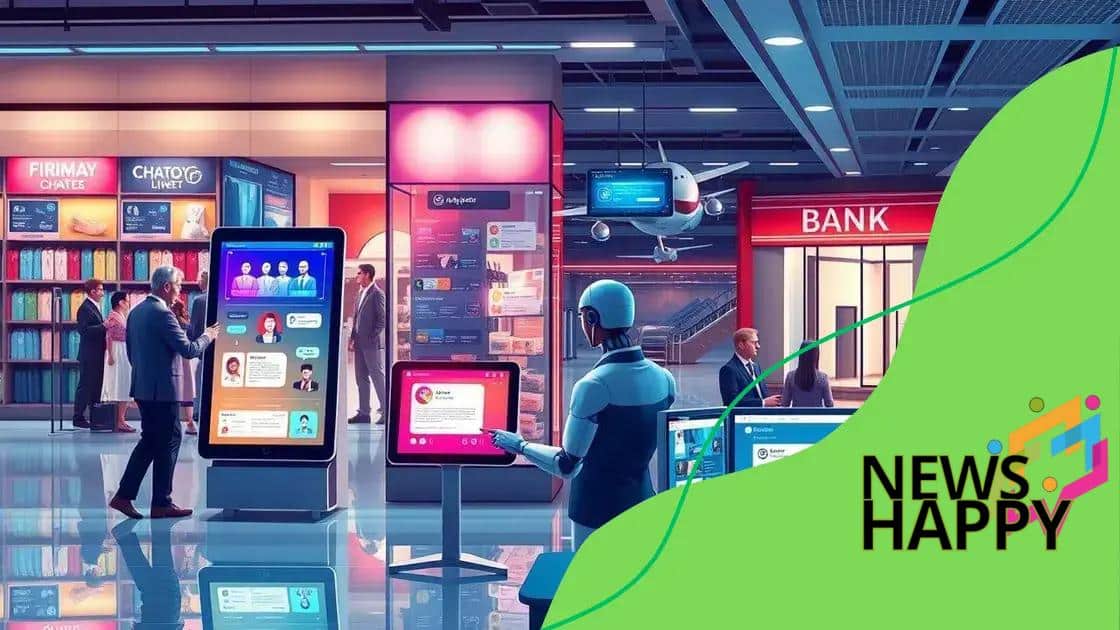How AI-driven chatbots are enhancing customer service experiences

Anúncios
AI-driven chatbots enhance customer service experiences by providing instant support, personalizing interactions, and optimizing efficiency, ultimately transforming how companies engage with their customers across various platforms.
How AI-driven chatbots are enhancing customer service experiences is a topic that many businesses are eager to explore. Have you ever chatted with a bot that actually understood your needs? This article dives into how these chatbots are changing the game.
Anúncios
Understanding AI-driven chatbots
When we talk about AI-driven chatbots, we refer to advanced systems that use artificial intelligence to simulate conversation with users. These bots can be programmed to assist customers, answer questions, and even solve problems. They are becoming increasingly popular because they can provide instant support, making customer interactions more efficient.
What Do AI-driven Chatbots Do?
AI-driven chatbots are designed to perform various tasks that enhance user experience. Here are some key functions:
- Responding to frequently asked questions.
- Assisting users with online transactions.
- Providing personalized recommendations.
- Handling complaints and feedback.
By taking care of these tasks, chatbots enable businesses to focus on more complex inquiries. They also help reduce wait times for customers, which is a significant improvement in customer service.
Anúncios
How Do They Work?
The power of AI-driven chatbots lies in their ability to learn from interactions. They use Natural Language Processing (NLP) to understand user input better. This technology allows chatbots to interpret the meaning behind words, making conversations more human-like.
As users interact with chatbots, the system collects data and refines its responses. Over time, the chatbot becomes more intelligent and better at addressing a wide range of customer needs. This continuous improvement is crucial for maintaining a high level of service.
Moreover, these bots can be integrated with various platforms, such as websites, social media, and mobile apps. This integration allows businesses to reach customers wherever they are, enhancing accessibility and convenience.
Benefits of Implementing Chatbots
There are numerous benefits to implementing AI-driven chatbots in customer service. Some notable advantages include:
- Cost efficiency by reducing the need for large customer service teams.
- 24/7 availability for customers.
- Scalability to handle many inquiries simultaneously.
- Improved user satisfaction with swift responses.
Overall, AI-driven chatbots are revolutionizing how businesses approach customer interactions. Their ability to provide immediate assistance while continuously learning makes them invaluable tools in modern customer service strategies.
Benefits of using chatbots in customer service
Using chatbots in customer service brings significant advantages to businesses and customers alike. These digital assistants streamline communication, making interactions smoother and faster.
Enhancing Efficiency
One major benefit is the efficiency that chatbots provide. They can handle multiple inquiries at once, reducing the waiting time for customers. This immediacy fosters a better user experience. When businesses deploy chatbots, they can respond to customer needs instantly, ensuring that no query goes unanswered.
- Available 24/7, offering assistance at any time.
- Quick responses to various customer inquiries.
- Reduction in backlog for human agents.
- Ability to manage peak times with ease.
This level of efficiency not only improves customer satisfaction but also allows human agents to focus on more complex issues, ultimately optimizing the customer service process.
Cost Savings
Implementing AI-driven chatbots can lead to significant cost savings for companies. By automating responses to common questions, businesses can reduce the size of their customer service teams. This efficient allocation of resources allows companies to invest in other areas, such as improving product quality and expanding their services.
Additionally, the savings on staffing costs can be redirected to enhance technological infrastructure and marketing efforts. This strategic allocation helps businesses stay competitive.
Personalization of Service
Another key advantage is the ability of chatbots to offer personalized interactions. They can collect data from previous interactions and tailor their responses based on user preferences. This personalization leads to a more engaging experience for customers.
- Customized recommendations based on past purchases.
- Targeted offers that reflect user interests.
- Follow-ups on previous inquiries or complaints.
With personalization, customers feel valued and more inclined to remain loyal to a brand. This loyalty translates to increased customer retention and potentially higher revenue.
In conclusion, the benefits of using chatbots in customer service are substantial. From enhancing efficiency to providing cost savings and personalized experiences, chatbots are reshaping how businesses interact with their customers.
Real-world examples of chatbot success

Many companies have successfully implemented chatbots to improve their customer service experiences. These real-world examples show how effective chatbots can be in diverse industries.
Retail Industry
In the retail sector, chatbots provide immediate responses to customer inquiries about sales, product availability, and shipping details. For instance, a well-known clothing retailer uses a chatbot to help customers navigate their online store. This bot guides users through product selections and provides personalized recommendations based on past purchases.
- Increased customer engagement through tailored product suggestions.
- Reduction in cart abandonment rates due to real-time assistance.
- Enhanced customer satisfaction with quick answers to common questions.
This retail chatbot has significantly boosted sales and improved overall customer satisfaction scores.
Travel and Hospitality
In the travel industry, chatbots play a vital role in booking and customer support. Airlines, for example, have deployed chatbots to assist travelers with flight bookings, cancellations, and provide real-time flight updates. One major airline’s chatbot can handle thousands of inquiries during peak travel seasons.
Customers enjoy the convenience of checking flight statuses or making changes to bookings without long waits on the phone. This effectiveness leads to fewer operational costs while keeping customers informed and happy.
Banking and Finance
The banking sector also benefits from AI-driven chatbots. One prominent bank utilizes a chatbot that helps users check their account balances, transfer funds, and provide financial advice. This digital assistant can manage routine inquiries, freeing human agents for more complex customer needs.
- Improved response times for common banking inquiries.
- Enhanced security measures through verification processes via chatbots.
- Increased customer trust by providing immediate support.
The success of this banking chatbot demonstrates how automation can streamline essential services while offering personalized support.
These examples illustrate how chatbots can transform customer service across various industries. By enhancing customer experience, reducing workload for human agents, and providing immediate assistance, chatbots are an essential tool in modern customer service strategies.
Challenges in integrating chatbots
Integrating chatbots into existing customer service frameworks can present several challenges. Understanding these hurdles is crucial for companies looking to leverage this technology effectively.
Technical Difficulties
One of the most significant challenges is the technical integration of chatbots with existing systems. Businesses often use multiple platforms for customer service, including CRMs and databases. Ensuring that the chatbot can effectively communicate with these systems can be complicated. Sometimes, the chatbots may not have access to the latest information, leading to less effective interactions.
- Compatibility issues with legacy systems.
- Data synchronization problems.
- High initial setup costs for custom solutions.
Overcoming these technical barriers often requires having strong IT support to customize and maintain integrations.
User Experience Concerns
Another challenge involves ensuring a positive user experience. While chatbots can automate many tasks, customers expect them to understand their requests accurately. If a chatbot fails to comprehend a question, it can lead to frustration.
To minimize such issues, businesses need to invest in training the chatbot with diverse datasets. This helps the bot recognize different ways users may phrase their inquiries, improving response accuracy and customer satisfaction.
Maintaining a Human Touch
While chatbots excel at handling routine questions, they can struggle with complex interactions that require empathy and nuanced understanding. Customers often prefer speaking to a human when dealing with sensitive issues.
- Finding the right balance between chatbot and human interaction.
- Defining clear escalation paths for complex inquiries.
- Training staff to effectively manage inquiries that require human attention.
It’s essential for businesses to create a seamless transition from the chatbot to a human agent, ensuring customers don’t feel lost in the process.
These challenges highlight the need for careful planning when integrating chatbots into customer service operations. Addressing technical issues, focusing on user experience, and maintaining a human touch are crucial factors in successful chatbot implementation.
Future trends in AI customer service solutions
The future of AI customer service solutions looks promising, with advancements in technology paving the way for more efficient and personalized interactions. As businesses continue to adopt AI, several trends are emerging that will shape how customer support evolves.
Increased Use of Machine Learning
Machine learning is set to play a vital role in enhancing the capabilities of chatbots. This technology allows chatbots to learn from past interactions, improving their ability to respond accurately and contextually. As they gather data from every conversation, their responses will become more relevant and precise.
- Continuous improvement of response accuracy.
- Enhanced ability to understand complex queries.
- Better personalization based on user history.
This will significantly improve user satisfaction as customers receive more tailored support.
Omni-channel Support
The integration of AI-driven chatbots across multiple platforms is another trend on the rise. Customers expect a seamless experience whether they are using a website, mobile app, or social media. Businesses are working to create an omni-channel strategy that allows chatbots to provide consistent support across different channels.
This integration ensures that customers can start a conversation on one platform and continue it on another without losing context. The result is a more cohesive experience that enhances customer loyalty.
Greater Use of Voice Technology
Voice technology is gaining traction in customer service. As smart speakers and voice assistants become more popular, businesses are exploring how to incorporate voice interfaces into their customer support systems. Chatbots capable of voice interactions can provide hands-free assistance, making it easier for customers to access help while multitasking.
- Improvement in accessibility for users.
- Faster resolutions for common queries.
- Enhanced engagement through natural voice conversations.
This trend towards voice interactions is likely to redefine how customers communicate with brands, integrating a more human-like element into the experience.
As we look forward, it’s clear that the landscape of AI customer service solutions will continue to evolve. By embracing these trends, businesses can create more effective and satisfying customer experiences.
FAQ – Frequently Asked Questions about AI-driven Customer Service Solutions
What are the primary benefits of using AI-driven chatbots in customer service?
AI-driven chatbots enhance efficiency, provide 24/7 support, personalize customer interactions, and reduce operational costs.
How do chatbots improve the customer experience?
Chatbots offer instant responses to customer inquiries and can handle multiple conversations simultaneously, leading to faster service.
What challenges might businesses face when integrating chatbots?
Businesses may encounter technical difficulties, user experience concerns, and the need to balance automation with human interaction.
What trends are shaping the future of AI in customer service?
Future trends include increased use of machine learning, omni-channel support, and greater adoption of voice technology.





